| Listing 1 - 10 of 142 | << page >> |
Sort by
|
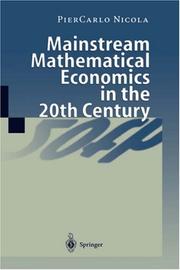
ISBN: 354067084X 3642086381 366204238X 9783540670841 Year: 2000 Publisher: Berlin Springer
Abstract | Keywords | Export | Availability | Bookmark
 Loading...
Loading...Choose an application
- Reference Manager
- EndNote
- RefWorks (Direct export to RefWorks)
To write everything about nothing, or to write nothing about everything: this is the problem. (Anonym, circa 1996-97) The first idea to write a book on M athematical Economics, more or less ordered in a historical sequence, occurred to me in 1995, when I was asked, by Istituto delta Enciclopedia Italiana, to write the entry "Storia dell'economia 1 2 matematica" , for the collective work "Storia deI XX Secolo". I thought that it would be interesting to elaborate on the text presented to the editors, to turn it into a book aiming at giving a panorama of what, in my opinion, are the main 20th century contributions to mathematical eco nomics. Of course, only a narrow set of the contributions made by economic theorists could be included, both for space limitations and necessity, because 3 of the limited competence of any single author. For instance, I have paid very limited attention to what is now called Macroeconomics, and also to Game Theory, which actually has grown so much as to acquire scientific in dependence as a living branch of applied mathematics. For the same reason, I have also left completely untouched such fields as Mathematical Finance, Public Economics, Theory of Taxation, etc. I have always based my presentation on published material only, assuming that what is contained in working papers still waits to be confirmed, possibly in the first years of the 21st century.
Quantitative methods (economics) --- Economics, Mathematical --- History --- Economic theory. --- Computer mathematics. --- Economic Theory/Quantitative Economics/Mathematical Methods. --- Computational Mathematics and Numerical Analysis. --- Computer mathematics --- Electronic data processing --- Mathematics --- Economic theory --- Political economy --- Social sciences --- Economic man --- Economics, Mathematical - History - 20th century
Book

ISBN: 3319498878 331949886X 9783319498867 Year: 2016 Publisher: Cham : Springer International Publishing : Imprint: Springer,
Abstract | Keywords | Export | Availability | Bookmark
 Loading...
Loading...Choose an application
- Reference Manager
- EndNote
- RefWorks (Direct export to RefWorks)
Focusing on special matrices and matrices which are in some sense `near’ to structured matrices, this volume covers a broad range of topics of current interest in numerical linear algebra. Exploitation of these less obvious structural properties can be of great importance in the design of efficient numerical methods, for example algorithms for matrices with low-rank block structure, matrices with decay, and structured tensor computations. Applications range from quantum chemistry to queuing theory. Structured matrices arise frequently in applications. Examples include banded and sparse matrices, Toeplitz-type matrices, and matrices with semi-separable or quasi-separable structure, as well as Hamiltonian and symplectic matrices. The associated literature is enormous, and many efficient algorithms have been developed for solving problems involving such matrices. The text arose from a C.I.M.E. course held in Cetraro (Italy) in June 2015 which aimed to present this fast growing field to young researchers, exploiting the expertise of five leading lecturers with different theoretical and application perspectives.
Mathematics. --- Computer mathematics. --- Numerical analysis. --- Numerical Analysis. --- Computational Science and Engineering. --- Mathematical analysis --- Computer mathematics --- Discrete mathematics --- Electronic data processing --- Math --- Science --- Mathematics --- Computer science. --- Informatics --- Matrices --- Algebra, Matrix --- Cracovians (Mathematics) --- Matrix algebra --- Matrixes (Algebra) --- Algebra, Abstract --- Algebra, Universal
Book
ISBN: 9780521762687 0521762685 9780511778810 9781107089372 9781107101241 1107101247 1107089379 0511778813 9781107095687 1107095689 1107103673 9781107103672 1107092434 9781107092433 113988686X Year: 2011 Volume: 132 Publisher: Cambridge : Cambridge University Press,
Abstract | Keywords | Export | Availability | Bookmark
 Loading...
Loading...Choose an application
- Reference Manager
- EndNote
- RefWorks (Direct export to RefWorks)
Relational mathematics is to operations research and informatics what numerical mathematics is to engineering: it is intended to help modelling, reasoning, and computing. Its applications are therefore diverse, ranging from psychology, linguistics, decision aid, and ranking to machine learning and spatial reasoning. Although many developments have been made in recent years, they have rarely been shared amongst this broad community of researchers. This comprehensive 2010 overview begins with an easy introduction to the topic, assuming a minimum of prerequisites; but it is nevertheless theoretically sound and up to date. It is suitable for applied scientists, explaining all the necessary mathematics from scratch using a multitude of visualised examples, via matrices and graphs. It ends with tangible results on the research level. The author illustrates the theory and demonstrates practical tasks in operations research, social sciences and the humanities.
Computer science --- Operations research --- Mathematics --- Mathematics. --- Operational analysis --- Operational research --- Industrial engineering --- Management science --- Research --- System theory --- Computer mathematics --- Electronic data processing --- Computer science - Mathematics --- Operations research - Mathematics
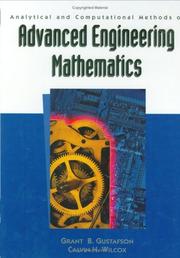
ISBN: 0387982655 1461268478 1461206332 9780387982656 Year: 1998 Volume: 28 Publisher: New York : Springer,
Abstract | Keywords | Export | Availability | Bookmark
 Loading...
Loading...Choose an application
- Reference Manager
- EndNote
- RefWorks (Direct export to RefWorks)
(NOTES)This text focuses on the topics which are an essential part of the engineering mathematics course:ordinary differential equations, vector calculus, linear algebra and partial differential equations. Advantages over competing texts: 1. The text has a large number of examples and problems - a typical section having 25 quality problems directly related to the text. 2. The authors use a practical engineering approach based upon solving equations. All ideas and definitions are introduced from this basic viewpoint, which allows engineers in their second year to understand concepts that would otherwise be impossibly abstract. Partial differential equations are introduced in an engineering and science context based upon modelling of physical problems. A strength of the manuscript is the vast number of applications to real-world problems, each treated completely and in sufficient depth to be self-contained. 3. Numerical analysis is introduced in the manuscript at a completely elementary calculus level. In fact, numerics are advertised as just an extension of the calculus and used generally as enrichment, to help communicate the role of mathematics in engineering applications. 4.The authors have used and updated the book as a course text over a 10 year period. 5. Modern outline, as contrasted to the outdated outline by Kreysig and Wylie. 6. This is now a one year course. The text is shorter and more readable than the current reference type manuals published all at around 1300-1500 pages.
Engineering mathematics. --- Mathématiques de l'ingénieur --- Mathématiques de l'ingénieur --- Engineering mathematics --- Applied mathematics. --- Mathematical analysis. --- Analysis (Mathematics). --- Computer mathematics. --- Mathematical and Computational Engineering. --- Applications of Mathematics. --- Analysis. --- Computational Mathematics and Numerical Analysis. --- Computer mathematics --- Electronic data processing --- Mathematics --- 517.1 Mathematical analysis --- Mathematical analysis --- Engineering --- Engineering analysis
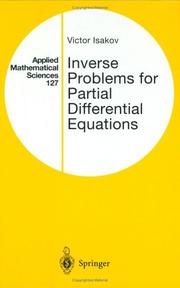
ISBN: 0387982566 1489900322 1489900306 9780387982564 Year: 1998 Volume: 127 Publisher: New York (N.Y.) Springer
Abstract | Keywords | Export | Availability | Bookmark
 Loading...
Loading...Choose an application
- Reference Manager
- EndNote
- RefWorks (Direct export to RefWorks)
This book describes the contemporary state of the theory and some numerical aspects of inverse problems in partial differential equations. The topic is of sub stantial and growing interest for many scientists and engineers, and accordingly to graduate students in these areas. Mathematically, these problems are relatively new and quite challenging due to the lack of conventional stability and to nonlinearity and nonconvexity. Applications include recovery of inclusions from anomalies of their gravitational fields; reconstruction of the interior of the human body from exterior electrical, ultrasonic, and magnetic measurements, recovery of interior structural parameters of detail of machines and of the underground from similar data (non-destructive evaluation); and locating flying or navigated objects from their acoustic or electromagnetic fields. Currently, there are hundreds of publica tions containing new and interesting results. A purpose of the book is to collect and present many of them in a readable and informative form. Rigorous proofs are presented whenever they are relatively short and can be demonstrated by quite general mathematical techniques. Also, we prefer to present results that from our point of view contain fresh and promising ideas. In some cases there is no com plete mathematical theory, so we give only available results. We do not assume that a reader possesses an enormous mathematical technique. In fact, a moderate knowledge of partial differential equations, of the Fourier transform, and of basic functional analysis will suffice.
517.95 --- Partial differential equations --- 517.95 Partial differential equations --- Mathematical analysis. --- Analysis (Mathematics). --- Computer mathematics. --- Mathematical physics. --- Analysis. --- Computational Mathematics and Numerical Analysis. --- Theoretical, Mathematical and Computational Physics. --- Physical mathematics --- Physics --- Computer mathematics --- Electronic data processing --- Mathematics --- 517.1 Mathematical analysis --- Mathematical analysis
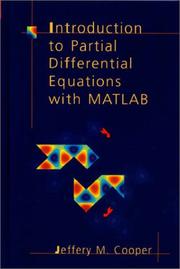
ISBN: 0817639675 3764339675 9780817639679 1461272661 1461217547 9783764339678 Year: 1998 Publisher: Boston (Mass.) : Birkhäuser,
Abstract | Keywords | Export | Availability | Bookmark
 Loading...
Loading...Choose an application
- Reference Manager
- EndNote
- RefWorks (Direct export to RefWorks)
Overview The subject of partial differential equations has an unchanging core of material but is constantly expanding and evolving. The core consists of solution methods, mainly separation of variables, for boundary value problems with constant coeffi cients in geometrically simple domains. Too often an introductory course focuses exclusively on these core problems and techniques and leaves the student with the impression that there is no more to the subject. Questions of existence, uniqueness, and well-posedness are ignored. In particular there is a lack of connection between the analytical side of the subject and the numerical side. Furthermore nonlinear problems are omitted because they are too hard to deal with analytically. Now, however, the availability of convenient, powerful computational software has made it possible to enlarge the scope of the introductory course. My goal in this text is to give the student a broader picture of the subject. In addition to the basic core subjects, I have included material on nonlinear problems and brief discussions of numerical methods. I feel that it is important for the student to see nonlinear problems and numerical methods at the beginning of the course, and not at the end when we run usually run out of time. Furthermore, numerical methods should be introduced for each equation as it is studied, not lumped together in a final chapter.
Differential equations, Partial --- Computer-assisted instruction --- Computer-assisted instruction. --- MATLAB. --- Computer mathematics. --- Fourier analysis. --- Mathematical analysis. --- Analysis (Mathematics). --- Partial differential equations. --- Computational Mathematics and Numerical Analysis. --- Fourier Analysis. --- Analysis. --- Partial Differential Equations. --- Partial differential equations --- 517.1 Mathematical analysis --- Mathematical analysis --- Analysis, Fourier --- Computer mathematics --- Electronic data processing --- Mathematics --- Differential equations, Partial - Computer-assisted instruction
Book
ISBN: 1447173384 1447173376 9781447173373 Year: 2017 Publisher: London : Springer London : Imprint: Springer,
Abstract | Keywords | Export | Availability | Bookmark
 Loading...
Loading...Choose an application
- Reference Manager
- EndNote
- RefWorks (Direct export to RefWorks)
Computational and numerical methods are used in a number of ways across the field of finance. It is the aim of this book to explain how such methods work in financial engineering. By concentrating on the field of option pricing, a core task of financial engineering and risk analysis, this book explores a wide range of computational tools in a coherent and focused manner and will be of use to anyone working in computational finance. Starting with an introductory chapter that presents the financial and stochastic background, the book goes on to detail computational methods using both stochastic and deterministic approaches. Now in its sixth edition, Tools for Computational Finance has been significantly revised and contains: Several new parts such as a section on extended applications of tree methods, including multidimensional trees, trinomial trees, and the handling of dividends; Additional material in the field of generating normal variates with acceptance-rejection methods, and on Monte Carlo methods; 115 exercises, and more than 100 figures, many in color. Written from the perspective of an applied mathematician, all methods are introduced for immediate and straightforward application. A ‘learning by calculating’ approach is adopted throughout this book, enabling readers to explore several areas of the financial world. Interdisciplinary in nature, this book will appeal to advanced undergraduate and graduate students in mathematics, engineering, and other scientific disciplines as well as professionals in financial engineering.
Mathematics. --- Economics, Mathematical. --- Computer mathematics. --- Economic theory. --- Quantitative Finance. --- Computational Science and Engineering. --- Economic Theory/Quantitative Economics/Mathematical Methods. --- Economic theory --- Political economy --- Social sciences --- Economic man --- Computer mathematics --- Discrete mathematics --- Electronic data processing --- Economics --- Mathematical economics --- Econometrics --- Mathematics --- Math --- Science --- Methodology --- Finance. --- Computer science. --- Informatics --- Funding --- Funds --- Currency question --- Finance --- Mathematical models. --- Economics, Mathematical . --- Finance - Mathematical models

ISBN: 3540428976 3662049635 9783540428978 Year: 2002 Publisher: Berlin Springer
Abstract | Keywords | Export | Availability | Bookmark
 Loading...
Loading...Choose an application
- Reference Manager
- EndNote
- RefWorks (Direct export to RefWorks)
This book can be understood as a model for teaching commutative algebra, taking into account modern developments such as algorithmic and computational aspects. As soon as a new concept is introduced, it is shown how to handle it by computer. The computations are exemplified with the computer algebra system Singular, developed by the authors. Singular is a special system for polynomial computation with many features for global as well as for local commutative algebra and algebraic geometry. The text starts with the theory of rings and modules and standard bases with emphasis on local rings and localization. It is followed by the central concepts of commutative algebra such as integral closure, dimension theory, primary decomposition, Hilbert function, completion, flatness and homological algebra. There is a substantial appendix about algebraic geometry in order to explain how commutative algebra and computer algebra can be used for a better understanding of geometric problems. The book includes a CD with a distribution of Singular for various platforms (Unix/Linux, Windows, Macintosh), including all examples and procedures explained in the book. The book can be used for courses, seminars and as a basis for studying research papers in commutative algebra, computer algebra and algebraic geometry.
Algebraic geometry --- Ordered algebraic structures --- Commutative algebra. --- 512.55 --- 512.55 Rings and modules --- Rings and modules --- Algebra --- Commutative algebra --- Algebra. --- Algebraic geometry. --- Algorithms. --- Computer mathematics. --- Computer science—Mathematics. --- Algebraic Geometry. --- Computational Mathematics and Numerical Analysis. --- Symbolic and Algebraic Manipulation. --- Computer mathematics --- Electronic data processing --- Mathematics --- Algorism --- Arithmetic --- Geometry --- Mathematical analysis --- Foundations
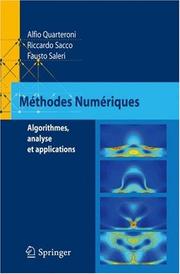
ISBN: 9788847004955 8847004950 8847004969 Year: 2007 Publisher: Milano : Springer Milan : Imprint: Springer,
Abstract | Keywords | Export | Availability | Bookmark
 Loading...
Loading...Choose an application
- Reference Manager
- EndNote
- RefWorks (Direct export to RefWorks)
Ce livre a pour but de présenter les fondements théoriques et méthodologiques de l'analyse numérique. Une attention toute particulière est portée sur les concepts de stabilité, précision et complexité des algorithmes. Les méthodes modernes relatives aux thèmes suivants sont presentées et analysées en détail: résolution des systèmes lineaires et non linéaires, approximation polynomiale, optimisation, intégration numérique, polynômes orthogonaux, transformations rapides, équations différentielles ordinaires. Les techniques presentées sont illustrées par de nombreux tableaux et figures. Beaucoup d'exemples et de contre-exemples sont proposés pour permettre au lecteur de développer son sens critique. Une caractéristique principale du livre réside dans l'abondance des programmes MATLAB qui accompagnent toutes les méthodes numériques présentées et qui les illustrent par des applications concrètes. Le lecteur détient ainsi tous les outils pour acquérir de solides connaissances théoriques et les appliquer directement sur ordinateur. Cet ouvrage s'adresse aux étudiants du second cycle des universités, aux élèves des écoles d'ingénieurs et, plus généralement, à toutes les personnes qui pratiquent le calcul scientifique.
calcul --- calculation --- Computer mathematics --- Mathematics. --- Mathematical analysis. --- Analysis (Mathematics). --- Computer mathematics. --- Computational Mathematics and Numerical Analysis. --- Analysis. --- Computer science --- Global analysis (Mathematics) --- Analysis, Global (Mathematics) --- Differential topology --- Functions of complex variables --- Geometry, Algebraic --- Discrete mathematics --- Electronic data processing --- Mathematics --- mathematics --- Numerical analysis --- Analyse numérique --- Global analysis (Mathematics). --- 517.1 Mathematical analysis --- Mathematical analysis --- Algèbre --- Matlab
Book
ISBN: 3662592045 3662592037 9783662592069 9783662592038 3662592061 Year: 2019 Publisher: Berlin, Heidelberg : Springer Berlin Heidelberg : Imprint: Springer,
Abstract | Keywords | Export | Availability | Bookmark
 Loading...
Loading...Choose an application
- Reference Manager
- EndNote
- RefWorks (Direct export to RefWorks)
This volume collects together research and survey papers written by invited speakers of a conference celebrating the 70th birthday of László Lovász. The topics covered include classical subjects such as extremal graph theory, coding theory, design theory, applications of linear algebra and combinatorial optimization, as well as recent trends such as extensions of graph limits, online or statistical versions of classical combinatorial problems, and new methods of derandomization. László Lovász is one of the pioneers in the interplay between discrete and continuous mathematics, and is a master at establishing unexpected connections, “building bridges” between seemingly distant fields. His invariably elegant and powerful ideas have produced new subfields in many areas, and his outstanding scientific work has defined and shaped many research directions in the last 50 years. The 14 contributions presented in this volume, all of which are connected to László Lovász's areas of research, offer an excellent overview of the state of the art of combinatorics and related topics and will be of interest to experienced specialists as well as young researchers.
Combinatorics. --- Computer science—Mathematics. --- Computer mathematics. --- Mathematical Applications in Computer Science. --- Mathematics --- Math --- Science --- Computer mathematics --- Electronic data processing --- Combinatorics --- Algebra --- Mathematical analysis --- Discrete mathematics. --- Computer science --- Discrete Mathematics. --- Mathematics. --- Discrete mathematical structures --- Mathematical structures, Discrete --- Structures, Discrete mathematical --- Numerical analysis
| Listing 1 - 10 of 142 | << page >> |
Sort by
|

 Search
Search Feedback
Feedback About
About Help
Help News
News